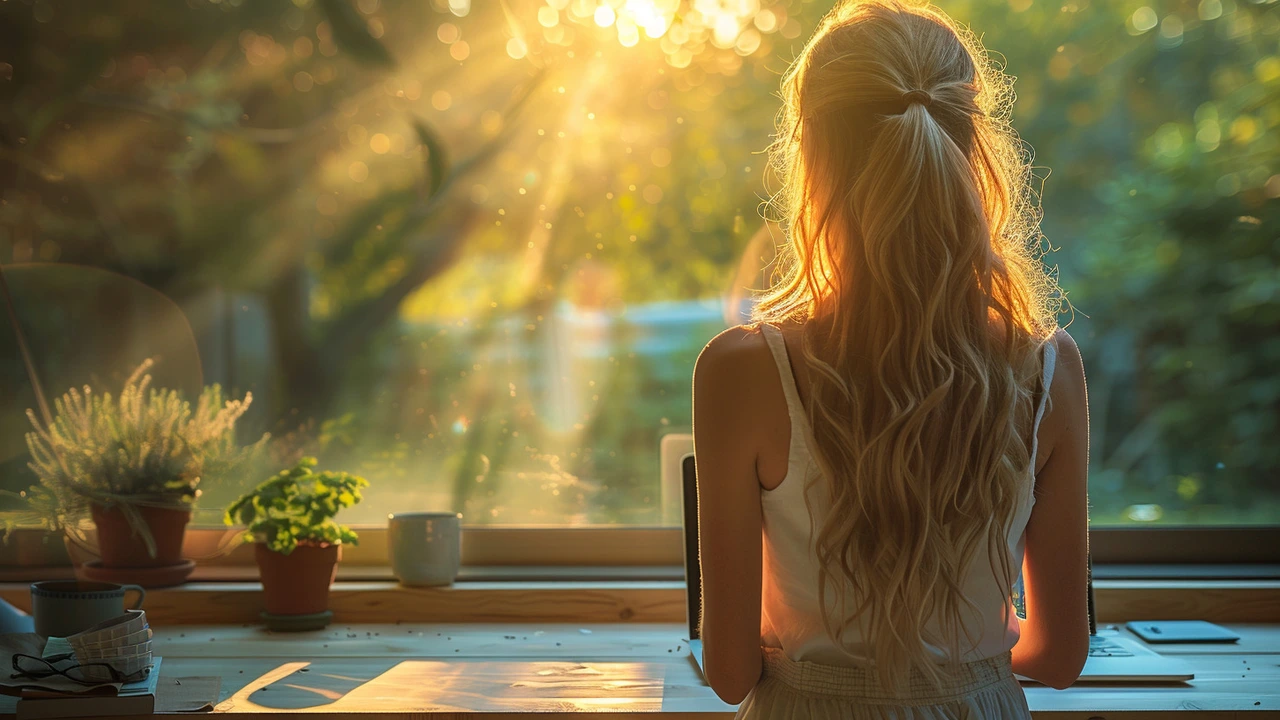Picture this: a workspace with only the essentials, a clean surface with room to breathe and think. This isn't just an aesthetic choice—it's a way to enhance your ability to think creatively. Minimalism, often thought of as a way to declutter and simplify life, reaches far beyond just clearing out physical space. It encompasses an approach that could fundamentally change how you generate and refine your ideas.
By removing the non-essential items from our lives, we allow more room for thought, energy, and creativity. It's like wiping the slate clean, giving you a clearer vision for what's truly important. This way of living and thinking provides the calm and focused environment necessary for creativity to flourish.
- The Minimalist Philosophy
- The Link Between Clutter and Creativity
- Real Life Success Stories
- Practical Decluttering Tips
- Maintaining a Minimalist Lifestyle for Creativity
The Minimalist Philosophy
Minimalism as a philosophy stretches back to more than just recent lifestyle trends; its roots can be traced to various cultures and philosophies around the world, advocating for simplicity and focusing on the essentials. The core idea of minimalism is about stripping away the unnecessary, leaving space only for what truly matters. This could relate not just to physical items but also to habits, relationships, and activities in our daily lives. The minimalist philosophy encourages a critical examination of one's surroundings and lifestyle choices, asking oneself repeatedly if each component is necessary and contributes positively to life’s goals.
The benefits of adopting a minimalist philosophy can manifest in various forms—mental clarity, increased productivity, reduced stress, and of course, enhanced creativity. When you have less to distract you, it becomes easier to focus and dig deep into your creative reserves. Think of a painter in a stark studio or a writer in a quiet, uncluttered room; environments like these aren't just about aesthetic appeal but are deliberately designed to foster a kind of mental openness and freedom.
Many have spoken about the liberating experience minimalism brings.
Joshua Fields Millburn & Ryan Nicodemus, known as 'The Minimalists', have said, 'Minimalism is the thing that gets us past the things so we can make room for life's important things—which aren't things at all.'Coming from leaders in the minimalist movement, this encapsulates the philosophical essence and transformative potential of minimalism beautifully.
Adopting minimalism doesn’t mean living without possessions. It’s about prioritizing things that serve you more than just materially. For example, in a minimalist home, you will find furniture and items that serve a purpose or bring joy, excluding redundant or duplicate items that add no value. This careful selection process promotes a more organized mind, which directly impacts creative thinking and problem-solving abilities.
In conclusion, exploring the minimalist philosophy involves much more than a superficial reduction of possessions. It is a mindful approach to life that challenges you to identify and focus on what is essential, opening up mental and physical space for creativity and growth. By reducing the clutter and noise, we not only simplify our lives but enrich them, making it easier to breathe, think, and create—the ultimate freedom for any creative mind.
The Link Between Clutter and Creativity
Let's delve into how clutter affects our mental capabilities, particularly creativity. A tidy environment often mirrors a tidy mind, and vice versa. Research from Princeton University Neuroscience Institute reveals that clutter can significantly overwhelm the visual cortex, impeding our ability to focus and process information. This cognitive overload is detrimental to creative processes that require attention, open-mindedness, and a high level of focus. Essentially, a cluttered space could mean a cluttered mind, where it becomes increasingly difficult to filter information and jumpstart the creative process.
In addition to the physical clutter, mental clutter also plays a significant role. Continuous distractions from a disorganized workspace can prevent deep, meaningful work from occurring. Mental clutter can include unfinished tasks, excessive information, and rampant thoughts—all barriers to expansive thinking. The challenge is real; clearing this type of clutter involves not only physical cleanup but also a structured approach to managing information and commitments. This holistic tidy-up can dramatically influence your mental clarity and creative output.
Minimalism isn't just about owning fewer things; it’s about intentional possession. It’s about only allowing things that have meaning and function to occupy your space. This simplicity paves the way for innovation because when the space around us is clear, our minds can experiment and create without restraint. The act of eliminating the non-essential allows us to focus on the work that matters—creating and innovating. Whether you’re a writer, artist, or any kind of creator, minimalism can be your ally in drawing out your best, most original ideas.
What does this look like in practical terms? It might mean regularly scheduling declutter sessions, digitally organizing files and emails, or setting up specific zones in your workspace for different types of work. These habits reduce the friction to get into the creative zone and make it easier to keep the momentum going once you’re there. The key takeaway is that a minimalist approach to both physical and mental possessions pays significant dividends in enhancing creativity.
To wrap up, the rush of clear spaces is not just a matter of aesthetic pleasure but a strategic approach to boosting creativity. Studies and personal anecdotes alike support the idea that reducing clutter—both physical and mental—can pave the way for more innovative thinking and fruitful creative sessions. Possibly, the next time you find yourself stuck creatively, look around—perhaps the solution is just a cleanup away.
Real Life Success Stories
A fascinating example of minimalism fueling creativity can be found in the story of Steve Jobs, co-founder of Apple Inc. Jobs was known for his minimalist approach not just in personal lifestyle but also in product design. This philosophy is clearly reflected in the clean, simple lines of Apple products, which many argue are conducive to sparking both user and creator creativity. Jobs believed that simplicity is the ultimate sophistication, and his work encouraged a focus on what was essential, stripping away the unnecessary. This ethos not only transformed a company but also influenced countless designers and innovators around the world.
In the literary world, famous Japanese author Haruki Murakami practices minimalism both in his writing style and his personal environment. He simplifies his surroundings to keep his mind focused on the complex narratives he weaves into his novels. Murakami's method shows the power of minimalism to enhance concentration and unleash a flow of new, creative ideas. His globally acclaimed work, which consistently features on bestseller lists, serves as proof that a minimalist approach can lead to rich, imaginative storytelling.
Visual artists also harness minimalism to enhance their creative process. One notable case is the renowned British sculptor Antony Gormley, whose stark, bold installations explore the human form in space. Gormley often uses minimalistic shapes and forms to create profound impacts, letting the empty space around his sculptures do the talking. His work encourages viewers to contemplate more deeply, proving that less can indeed be more. The success and worldwide recognition of Gormley's work highlight how minimalism doesn't diminish creativity but rather, amplifies it.
This synopsis barely scratches the surface of how minimalism has transformed various fields, enabling individuals to enhance their creative potential. It's not about living with less just for the sake of it, but rather, making room for more of what truly matters – more creativity, more originality, and more meaningful outputs. Minimalism, it turns out, might just be one of the keys to unlocking true creative potential in various domains of life and work.
Practical Decluttering Tips
Starting the journey towards a minimalist lifestyle involves more than a decision; it requires actionable steps tailored to personalize your needs. One of the first recommended steps involves identifying the areas of your life or spaces in your home that feel the most cluttered. This doesn’t just apply to physical items but extends to digital and mental clutter as well. The clearing of your workspace and home can significantly enhance your ability to focus and create, leading to higher productivity and an enriched creative pursuit. The psychology behind a clean environment is backed by numerous studies, showing improved concentration and lowered stress levels—are critical for creativity.
The KonMari Method, popularized by Marie Kondo, emphasizes keeping only those things that 'spark joy.' This criterion helps in discerning which items are essential and which are not. Starting with clothes, then moving to books, and later to papers, miscellaneous items, and sentimental items, this methodical approach ensures that everything you keep has a value. This not only clears the physical space but also helps in shaping a more deliberate and intentional lifestyle—a cornerstone of minimalist living.
Implement timing strategies such as the 12-12-12 challenge—finding 12 items to throw away, 12 to donate, and 12 to be returned to their proper place. This quick and simple exercise can make decluttering a more manageable and less daunting task. It adds a sense of game and challenge to the process, making it more engaging and less of a chore. Such practical steps ensure that decluttering is not seen as an insurmountable task but rather an enjoyable one that brings clear, tangible benefits to one’s quality of life and creative output.
Consider the digital space as well, which can often be a major source of distraction and clutter. Regular digital detoxes—where you limit your internet and social media usage—can significantly enhance mindfulness and concentration. Organize your digital files, unsubscribe from unneeded mailing lists, and declutter your desktop and mobile devices. By treating digital clutter with the same importance as physical clutter, you acknowledge its impact on your mental space and creativity.
The results of decluttering can be profound. A study by Princeton University Neuroscience Institute found that clutter can drastically affect your ability to focus and process information. The visual cortex can be overwhelmed by unnecessary stimuli within your surroundings, thereby reducing your capacity to focus. Simplifying your environment could, therefore, be directly linked to enhanced creativity and productivity. It's not just about less stuff—it's about creating more room for innovation and ideas.
Maintaining a Minimalist Lifestyle for Creativity
Adopting a minimalist lifestyle is one thing, but maintaining it—especially in a world filled with constant consumerism and digital distractions—is another challenge entirely. It involves more than just an initial purge of excess stuff; it’s about cultivating habits that support continuous focus and creativity. Regularly assessing what you own, and more importantly, why you own it, is crucial. This mindful approach helps in recognizing and eliminating the unnecessary, keeping only what serves a purpose or brings joy.
Creating routines that support a minimalist lifestyle is also vital. For example, starting and ending your day with a tidy workspace can greatly influence your mental clarity and ability to focus. Emphasizing the importance of a decluttered space, studies have shown that physical clutter competes for your attention, resulting in decreased performance and increased stress. Here, the minimalist approach directly contributes to a more productive creative process by minimizing distractions.
To effectively sustain minimalism, it's helpful to adopt digital minimalism as well. This involves streamlining your digital tools and platforms, keeping only those that are essential for your work and personal life. Email decluttering, limiting social media usage, and organizing digital files regularly can save a surprising amount of mental energy. This energy can instead be redirected towards creative pursuits, making digital minimalism a cornerstone of a sustainable minimalist lifestyle.
Furthermore, the minimalist philosophy points towards intentional living—making deliberate choices about how you spend your time and resources. This encourages a deeper connection to your creative endeavors, ensuring that every project or task has meaningful alignment with your goals. It also means saying no to projects or tasks that do not align with these values, which is often more difficult than it sounds. Setting these boundaries is necessary to maintain a clear focus and prevent burnout, enhancing overall creative output.
One practical tip for maintaining a minimalist lifestyle is the implementation of a "one in, one out" rule. For every new item you bring into your space, whether it's a tool, a piece of clothing, or even a digital app, ensure that an existing item is either discarded or repurposed. This practice not only keeps your physical and digital environments under control but also fosters a sense of ongoing mindfulness about what truly matters in your creative and personal life.




Leave a Comments